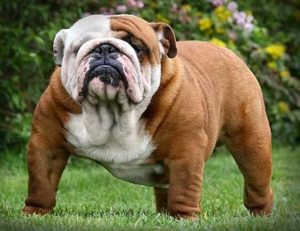When is an American Bully Dog Full Grown?
American Bully dogs typically reach their full grown size between 1.5 to 3 years of age. The exact timing can vary depending on various factors such as the dog’s genetics, diet, overall health, and individual growth rate. It’s important to note that while their physical growth may slow down around the 1.5 to 3 year mark, dogs can continue to fill out and mature in terms of muscle mass and overall body composition beyond this point.

What Impacts the Size of an American Bully Dog?
The size of an American Bully dog can be influenced by several factors, including:
Genetics: Genetics play a significant role in determining a dog’s size. The size of the dog’s parents and ancestors can influence how big the dog will ultimately become. Breeders often select for specific traits, including size, when breeding American Bully dogs.
Pedigree: The dog’s pedigree, which includes information about its lineage and ancestry, can impact its size. If the dog comes from a line of larger dogs, it’s more likely to be larger itself.
Nutrition: Proper nutrition is essential for healthy growth. Puppies need a balanced diet with the right amount of protein, vitamins, and minerals to support their growth. However, overfeeding can lead to excessive weight gain and potential health problems.
Health: Any health issues during the dog’s growth phase can impact its size. Certain medical conditions can lead to stunted growth or other developmental issues that affect the dog’s overall size and stature.
Exercise: The level of exercise a dog gets during its growth period can impact muscle development and overall body composition. Regular exercise can promote healthy growth and development.
Neutering/Spaying: Early neutering or spaying can affect the timing of growth plate closure, potentially leading to slightly different growth patterns. Discuss the best timing for these procedures with your veterinarian.
Environmental Factors: Environmental conditions and stress can also impact growth. A stressful or unstable environment might affect a dog’s overall health and development.
Breed Variability: The American Bully breed has different size categories (Standard, Classic, Pocket, and XL), and each category has a different range of acceptable sizes. Breeders may focus on breeding for specific size categories, leading to some variation within the breed.
It’s important to work closely with a veterinarian, follow proper nutrition guidelines, and provide appropriate care to ensure that an American Bully dog reaches its potential size in a healthy and balanced manner.
How Big Do American Bully Dogs Get?
American Bully dogs come in several different size categories, each with its own range of acceptable sizes. The four main size categories for American Bully dogs are Standard, Classic, Pocket, and XL. Here are the general height and weight ranges for each category:
Standard: Height: 17 to 20 inches (43 to 51 cm) at the withers (shoulder). Weight: 70 to 120 pounds (32 to 54 kg).
Classic: Height: 17 to 20 inches (43 to 51 cm) at the withers (shoulder). Weight: 60 to 100 pounds (27 to 45 kg).
Pocket: Height: 13 to 17 inches (33 to 43 cm) at the withers (shoulder). Weight: 35 to 60 pounds (16 to 27 kg).
XL (Extra Large): Height: 20 inches (51 cm) and up at the withers (shoulder). Weight: 80 pounds (36 kg) and up.
It’s important to note that these are general ranges, and individual dogs can fall outside of these ranges while still being considered healthy and within the breed standard. The size of an American Bully dog can also be influenced by factors such as genetics, diet, exercise, and overall health. If you’re considering getting an American Bully dog, it’s a good idea to research the specific size category you’re interested in and consult with reputable breeders to understand the potential size range for that category.
When Do American Bully Dogs Stop Growing?
American Bully dogs generally stop their rapid growth phase by around 1.5 to 2 years of age. However, it’s important to note that while their height may have reached its maximum potential by this age, some dogs may continue to fill out and develop muscle mass for another year or so, ultimately achieving their full mature body composition by around 2.5 to 3 years of age.
Keep in mind that individual dogs can vary in their growth patterns, and factors like genetics, nutrition, exercise, and overall health can influence when a specific dog reaches its full size and physical maturity. Regular veterinary check-ups and discussions with a veterinarian can help monitor the dog’s growth and ensure it’s developing in a healthy and balanced manner.
When Do American Bully Dogs Calm Down?
American Bully dogs, like many breeds, tend to become less hyperactive and more settled as they mature. The age at which they “calm down” can vary from dog to dog, but in general, you can expect American Bully dogs to start showing signs of decreased hyperactivity and increased calmness as they reach adulthood, which is usually around 1.5 to 3 years of age.
Puppies and young dogs are typically more energetic, playful, and curious as they explore the world around them. As they mature, their energy levels often start to stabilize, and they become more focused, responsive, and adaptable. However, it’s important to remember that individual temperament, training, socialization, and overall personality also play significant roles in a dog’s behavior.
Proper training, consistent exercise, mental stimulation, and socialization are key factors in helping your American Bully dog develop into a well-behaved and balanced adult. Positive reinforcement training methods can help teach them appropriate behaviors and reinforce calmness.
If you find that your American Bully dog’s hyperactivity or behavior is a concern, seeking guidance from a professional dog trainer or behaviorist can be beneficial in creating a structured training plan tailored to your dog’s needs.
Do Males and Females Grow the Same Size?
In general, male and female American Bully dogs can have some differences in size, but these differences may not be as pronounced as in some other breeds. Here are a few considerations:
Size Variation: Within each size category (Standard, Classic, Pocket, and XL), both male and female American Bully dogs can vary in size. This means that you might find some females that are larger than some males and vice versa.
Males Tending to be Larger: In many dog breeds, males tend to be slightly larger than females. This can be the case with American Bully dogs as well, especially in the Standard and XL categories. However, the differences in size might not be extremely significant.
Individual Variation: Genetics play a significant role in determining a dog’s size. If a female American Bully dog comes from a line of larger individuals, she might be larger herself, and the same goes for males from smaller lines.
Nutrition and Health: Proper nutrition and health care can impact a dog’s growth. A well-balanced diet and regular exercise can promote healthy growth and help a dog reach its potential size, regardless of gender.
Pedigree: The dog’s pedigree and lineage can also influence its size. If both the parents and ancestors of a dog are larger or smaller, this can affect the size of the individual dog.
It’s important to remember that while size differences can exist, the overall health, temperament, and quality of the dog are more important factors to consider when choosing a pet. If size is a specific concern for you, it’s recommended to discuss this with a reputable breeder who can provide information about the size tendencies in their breeding lines.
How To Measure the size of an American Bully Dog?
Measuring the size of an American Bully dog involves taking specific measurements that provide an accurate representation of the dog’s height and weight. Here’s how you can measure the size of an American Bully dog:
Height Measurement:
- Use a measuring tape or a yardstick that’s marked in inches or centimeters.
- Measure the height of the dog at the highest point of its shoulder, which is also known as the “withers.” This is where the neck meets the back.
- Have the dog stand on a level surface with its front legs positioned naturally.
- Hold the measuring tape straight against the dog’s withers and record the measurement in inches or centimeters.
Weight Measurement:
- Use a digital or analog scale that can accurately measure the weight of the dog.
- If the dog is small enough to be held comfortably, weigh yourself first, then weigh yourself while holding the dog, and subtract your weight from the combined weight to get the dog’s weight.
- If the dog is too large to be held, use a platform scale that the dog can stand on comfortably.
It’s important to ensure that the dog is calm and relaxed during the measurements to get accurate results. If the dog is not comfortable with the process, it might help to have a friend or family member assist by providing treats or distractions.
Keep in mind that size measurements can vary slightly based on factors such as the dog’s stance, the measuring technique used, and the accuracy of the measuring tools. For breed standards and show purposes, measurements are usually taken under specific conditions to ensure consistency and accuracy. If you’re looking for precise measurements for show or breeding purposes, consulting with experienced breeders or professionals familiar with the breed standards can be helpful.
American Bully Dog Life Expectancy
The life expectancy of an American Bully dog can vary based on several factors, including genetics, overall health, diet, exercise, and the quality of care provided. On average, American Bully dogs have a life expectancy of around 10 to 12 years. However, some dogs may live longer, while others may have a shorter lifespan.
To help ensure a longer and healthier life for your American Bully dog, consider the following:
Quality Nutrition: Provide a balanced and appropriate diet that meets the dog’s nutritional needs. Consult with a veterinarian to determine the best diet for your dog’s age, size, and health.
Regular Exercise: Engage your dog in regular physical activity to maintain a healthy weight and promote overall fitness. Playtime, walks, and interactive games can help keep your dog active.
Routine Veterinary Care: Schedule regular check-ups with a veterinarian to monitor your dog’s health and catch any potential issues early. Stay up-to-date on vaccinations, parasite control, and dental care.
Mental Stimulation: Provide mental enrichment through training, puzzle toys, and interactive activities to keep your dog’s mind engaged.
Socialization: Properly socialize your dog with other dogs and people to help them become well-adjusted and confident in different environments.
Grooming: Regular grooming, including brushing, nail trimming, and ear cleaning, can contribute to your dog’s overall well-being.
Health Monitoring: Keep an eye out for any changes in behavior, appetite, energy levels, or physical condition. Early detection of health issues can lead to more effective treatment.
Spaying/Neutering: Discuss the appropriate timing for spaying or neutering your American Bully dog with your veterinarian. This can impact their overall health and longevity.
It’s important to note that larger American Bully dogs (such as those in the XL category) may have slightly shorter lifespans compared to smaller-sized dogs. Additionally, working with responsible breeders who prioritize health and genetic diversity can contribute to the overall health and longevity of the breed.
Fun Facts About American Bully Dogs
Certainly, here are some fun facts about American Bully dogs:
Breed Origins: The American Bully breed originated in the United States and was developed by crossbreeding various bulldog and terrier breeds. They were initially bred for their loyalty, companionship, and suitability as family pets.
Varied Size Categories: American Bully dogs come in four main size categories: Standard, Classic, Pocket, and XL. Each category has its own range of acceptable sizes, allowing for a variety of options within the breed.
Friendly and Social: American Bully dogs are known for their friendly and sociable nature. They often get along well with children, other pets, and strangers, making them great family companions.
Muscular Build: These dogs are recognized for their muscular and well-defined bodies. They have a strong and athletic appearance, which adds to their appeal.
Loyal Companions: American Bully dogs are known for their loyalty and devotion to their families. They form strong bonds with their owners and can be very protective when needed.
Trainable: With proper training and socialization, American Bully dogs are generally quite trainable. They respond well to positive reinforcement techniques and enjoy being mentally stimulated.
Low Maintenance Coat: The coat of an American Bully dog is short and smooth, requiring minimal grooming. Regular brushing can help keep their coat looking shiny and healthy.
Variety of Colors: American Bully dogs come in a wide range of coat colors and patterns, including solids, patches, and brindles. This variety adds to their visual appeal.
Therapy and Service Dogs: Due to their gentle and people-oriented nature, some American Bully dogs are used as therapy dogs or trained to assist individuals with disabilities as service dogs.
Community Involvement: American Bully enthusiasts often engage in various dog-related activities such as dog shows, sports, and community events to showcase the positive qualities of the breed.
Remember that each individual dog is unique, and while these facts apply to the breed as a whole, there can always be variations in personality and behavior based on factors like genetics, upbringing, and socialization.
American Bully Dog Full Grown: Frequently Asked Questions
Q: When is an American Bully dog considered fully grown?
A: American Bully dogs are generally considered fully grown between 1.5 to 3 years of age. This varies based on factors such as genetics, nutrition, and overall health.
Q: How big do American Bully dogs get?
A: American Bully dogs come in four size categories: Standard, Classic, Pocket, and XL. Sizes can range from around 13 inches in height for Pocket dogs to over 20 inches for XL dogs, with corresponding weight ranges.
Q: Do male and female American Bully dogs grow the same size?
A: While males may tend to be slightly larger than females in some cases, individual size variations can occur within both genders. Genetics and lineage play a role in determining size.
Q: When do American Bully dogs stop growing in height?
A: American Bully dogs generally stop their rapid height growth by around 1.5 to 2 years of age. However, they may continue to develop muscle and fill out for another year or so.
Q: When do American Bully dogs calm down?
A: American Bully dogs typically become less hyperactive and more settled as they mature, which is usually around 1.5 to 3 years of age. Training, socialization, and exercise influence their behavior.
Q: How can I measure the size of my American Bully dog accurately?
A: To measure your American Bully dog’s size, use a measuring tape for height and a scale for weight. Measure height at the withers and weigh your dog on a scale, ensuring it’s calm during measurements.
Q: What is the life expectancy of an American Bully dog?
A: The life expectancy of American Bully dogs is around 10 to 12 years, though individual lifespans can vary. Proper care, nutrition, and regular veterinary visits contribute to a longer and healthier life.
Q: Are American Bully dogs good family pets?
A: Yes, American Bully dogs are often known for their friendly and sociable nature, making them good family companions. Proper training and socialization are essential for their well-rounded behavior.
Q: Are American Bully dogs suitable for therapy or service work?
A: Some American Bully dogs possess the temperament and qualities needed for therapy or service work. Their gentle demeanor and people-oriented nature can make them effective therapy or service animals.
Q: What are some fun facts about American Bully dogs?
A: American Bully dogs have a varied size range, are known for their loyalty and muscular build, come in a variety of coat colors, and can excel in activities like dog shows and community involvement.
Conclusion
In conclusion, American Bully dogs are a unique and captivating breed with a wide range of sizes and characteristics. Understanding their growth patterns, behavior, and care needs is essential for providing them with a happy and healthy life. From their diverse size categories to their friendly and loyal nature, American Bully dogs offer a blend of charm and companionship. By ensuring proper nutrition, regular exercise, socialization, and veterinary care, you can help your American Bully dog thrive and enjoy a long and fulfilling life as a cherished member of your family.






